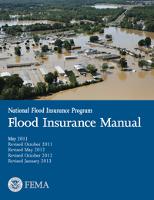DACF Home → Bureaus & Programs → Maine Floodplain Management Program → Flood Insurance
Flood Insurance
About the National Flood Insurance Program
The National Flood Insurance Program (NFIP) is a voluntary program that offers community residents the opportunity to purchase flood insurance provided by the Program in exchange for the community's commitment to practice sound land use management. Currently, there are over 5,000 flood insurance policies in effect in Maine with coverage totaling over $1.4 billion. Mortgage loans and disaster assistance are severely limited in communities that do not participate in the NFIP.
Is Your Community Participating in the National Flood Insurance Program (NFIP)?
Check it out here FEMA Maine Community Status Book.
Please visit FEMA's FloodSmart web site to find out about flood insurance policies and coverage, finding an agent in your area, how to purchase flood insurance, how to file a claim, and more.
National Flood Insurance Program
In 1968, Congress created the National Flood Insurance Program (NFIP) in response to the rising cost of taxpayer funded disaster relief for flood victims and the increasing amount of damage caused by floods.
The Federal Insurance and Mitigation Administration (FIMA), a component of the Federal Emergency Management Agency (FEMA), manages the NFIP and oversees the floodplain management and mapping components of the Program. Nearly 20,000 communities across the United States and its territories participate in the NFIP by adopting and enforcing floodplain management ordinances to reduce future flood damage. In exchange, the NFIP provides flood mapping and makes Federally backed flood insurance available to homeowners, renters, and business owners in these communities. Flood damage is reduced by nearly $1 billion a year through partnerships with communities, the insurance industry, and the lending industry. Further, buildings constructed in compliance with NFIP building standards suffer approximately 80 % less damage annually than those not built in compliance. And, every $3 paid in flood insurance claims saves $1 in disaster assistance payments.
The NFIP is self-supporting for the average historical loss year, which means that operating expenses and flood insurance claims are not paid for by the taxpayer, but through premiums collected for flood insurance policies. The Program has borrowing authority from the U.S. Treasury for times when losses are heavy, but these loans are paid back with interest.
Flood Insurance is required by law
To get secured financing to buy, build, or improve structures in Special Flood Hazard Areas (SFHAs) property owners are required to purchase flood insurance. Lending institutions that are federally regulated or federally insured must determine if the structure is located in a SFHA and must provide written notice requiring flood insurance.
Flood insurance is available to any property owner or renter located in a community participating in the NFIP. All areas are susceptible to flooding, although to varying degrees, in fact, 25% of all flood claims occur in the low-to-moderate risk areas. Flooding can be caused by heavy rains, melting snow, by inadequate drainage systems, failed protective devices such as levees and dams, as well as by tropical storms and hurricanes.
There's a big difference between having to buy flood insurance because the law says you must and choosing to buy flood coverage because it's in your best interest to do so. All property owners should review the flood risk in their area and consider purchasing flood insurance because it is the best means of recovery from flood damage. Keep the peace of mind in knowing that your property will be insured for damages from the next storm and that you're not left to cover the losses yourself.
Floodplain Management
Floodplain management is the operation of an overall program of corrective and preventative measures for reducing flood damage, including but not limited to, floodplain management regulations, emergency preparedness plans, and flood control works. Examples include mapping communities to identify flood prone areas, elevating buildings above the base flood and relocating structures out of the floodplain.
An important element in making flood insurance available to home and business owners is a community's agreement to adopt and enforce floodplain management ordinances, particularly with respect to new development. A sound floodplain management operation cannot only ensure that flood insurance will always be available but can also have a beneficial impact on coverage and premiums.
The Federal Insurance and Mitigation Administration (FIMA) at FEMA is the organization responsible for working with states and their communities. The states work with communities to encourage them to adopt and enforce ordinances that meet or exceed the minimum floodplain management requirements of the National Flood Insurance Program.
Frequently Asked Questions
FEMA has released the National Flood Plain Insurance Program's brochure "Top Ten Facts for Consumers". This brochure is a great place to start if you have basic questions about flood insurance.
How Floodplain Insurance Works
What you Need to Know about the National Floodplain Insurance Program (NFIP)
Save Money on Your Flood Insurance
This link will take you to FEMA's web site where you will find a wealth of information pertaining to federal flood insurance.
You may also contact the Maine Floodplain Management Program at 287-8063 for assistance with flood insurance issues.
